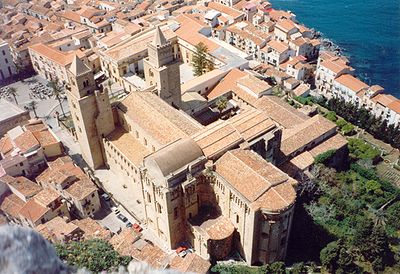CEFALÙ
Dominating from a lofty rock
rising out of the frontal area of the Northern coast of Sicily,
Cefalù has been inhabited since a pre-Greek age, as
testified by traces of human settlements found in the caves
of the same rock.
Its name was Kephaloidíon during the Greek era, which
was derived from the term Kefalé meaning precisely
head.
It was governed alternately by Greeks and Carthaginians until
the end of 254 BC, when it was overtaken by the Romans during
the historical second Punic Wars and became known as Cephaloedium.
Through Rome, it became a Decuman city, and during the imperial
age, a waged city, seeing the beginning of the minting of
its own currency.
It then became an Episcopal seat, and after Vandali rule and
being part of the Ostrogoth Reign of Italy, it became part
of the Byzantine dominion. .
Under Bisanzio, the City was transferred onto the rocks, to
defend itself from further seaward attacks.
After two long sieges during ‘838 and ‘858, it
was overtaken by the Arabs, who named it Gafludi.
In 1063, it was overtaken by Count Ruggero d’Altavilla,
future King Ruggero I of Sicily. Under Norman rule, the inhabitants
moved further along the coast and monuments and churches were
built as testimony to a period of development and splendour.
During the entire historical period, from Norman to Aragonese
rule, Cefalù was a fortified city with imposing defence
walls, in case of attack from the seaward direction.
In 1861, the City was annexed to the Reign of Italy.
Today Cefalù is a touristic meta of notable interest,
both for its sea and its beach, as well as the wealth of art
it conserves and offers to a more demanding visitor –
an example is its beautiful Cathedral which was constructed
in 1131 under the reign of Ruggero II d’Altavilla.
Amongst the most worthy civil buildings of note, we highlight
the l'Osterio Magno, probably residence of King Ruggero (13th
Century), the Palazzo Vescovile of 1793 and the Palazzo Piraino
in Piazza del Duomo, where one can also find the ex Monastery
of Saint Caterina, and Palazzo Atenasio Martino (15th Century).
The Church of S. Salvatore, outside the wall, is also very
beautiful as well as the Church dell’Itria.
The archaic fortifications are also visible along the rocks,
in the Fontana locality.
|
